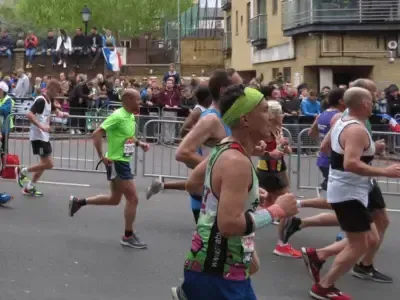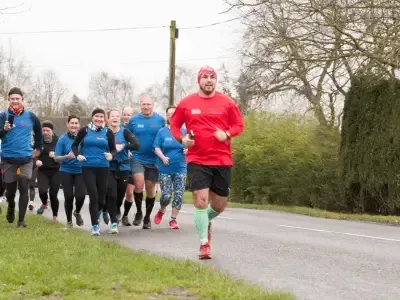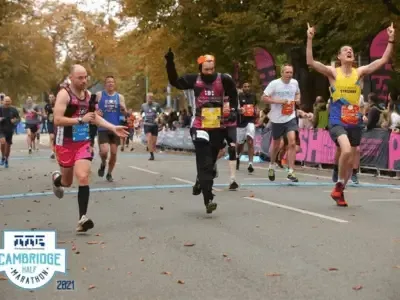Runpreneur Journey Blog
Embark on an extraordinary journey with the Runpreneur community. Discover inspiring stories, insider tips, and the transformative power of our global challenge. From first-time runners to seasoned athletes, our blog captures the essence of the Runpreneur movement, inspiring others to join the cause.

Rehabilitating Long-term Injuries: My Approach and Insights
Rehabilitating Long-term Injuries: My Approach and Insights
Hello everyone,
So today, I want to delve into a topic that is quite pertinent to anyone who maintains a regular exercise regime: recovering from longer-term niggling injuries. If you're someone who wrestles with recurring injuries that you just can't seem to shake, keep reading. Hopefully, you’ll find my experience and insights useful.
Welcome back to what is now consecutive day 1605 of my "Diary of a Runpreneur." You all know my mission: saving children's lives by attempting the ultimate ultramarathon of run vlogging on consecutive days, covering the distance of a lap around the world, barefoot style. Your support through subscribing, sharing, liking, and commenting helps raise more money and save more children's lives. I appreciate your continuous support.
Now, let’s get into today’s subject, which is close to my heart due to a recent niggling injury of my own. Perhaps it sounds familiar: you’ve got a recurring pain that stubbornly won't go away, and because you’re committed to regular exercise, it's particularly frustrating.
To provide some context, I believe I'm currently suffering from runner’s knee. Specifically, there's some discomfort on the right side of my patella, or kneecap. This likely stems from an alignment issue in my running technique, an issue that's aggravated by the stress I endure during marathons. For instance, during the Loch Ness Marathon, I struggled with foot issues, including hard skin and corns—all too common for barefoot runners like myself.
Corns are particularly problematic as they disrupt your body's natural alignment. Your body is clever and tends to compensate for pain, so I ended up landing off-center on my left foot to avoid the pain from the corn. This misalignment likely contributed to my knee issues. Post-marathon, I recognized the importance of my feet's condition, even though I had been neglecting them despite regular sports massages.
Prevention is better than the cure, so my first step was scheduling regular podiatrist meetings every eight weeks. While this might sound unappealing, maintaining the right amount of hard skin is essential. Too little skin can't protect, and too much can cause corns and alignment issues. I also plan to use silicone gel strips during endurance events to help prevent future blisters and hard skin formation.
But what about the now? My current focus is on managing and recovering from my runner’s knee. This issue, common among runners who push too hard, has lingered for about three weeks since the marathon. Typically, recovery runs help me overcome such issues, but this time, no such luck.
Here's my game plan: I’ve booked a sports massage and another podiatrist appointment for the coming weeks. In the meantime, I’m drastically slowing my running pace to over six minutes per kilometer, significantly reducing the impact on my joints. Although this pace feels incredibly slow, it should aid recovery by ensuring blood circulation while minimizing stress.
I’m also shifting to my Vibram Five Fingers V-Trail 2.0, which provides slightly more cushioning than my usual barefoot-style running shoes. This might offer the extra support my knees need.
Checking my readiness for an 11-mile off-road run in November will depend on how my knee fares mid-November. Because the ultimate goal is regaining full fitness for two marathons next spring, any immediate races are secondary.
From my experience, I’ve learnt that a few key steps can help manage recurring injuries:
Prevention: Regularly see specialists like podiatrists, physiotherapists, and sports masseurs.
Recovery Mode: Lower intensity and impact on your workouts to keep moving without exacerbating the injury.
Patience: Allow your body the time and rest it needs to heal fully.
For me, the quote by Sir Benjamin Franklin, "Failing to plan is planning to fail," rings true. I've structured my recovery plan and now need to execute it meticulously. I hope sharing my journey helps others facing similar challenges.
Questions or comments? Drop me a line! Don’t forget to subscribe, share, like, and comment to support my mission of saving children’s lives through running. Thank you for your continued support.
Stay positive, stay happy, and see you tomorrow.
Kevin Brittain

Kevin's 40,075km Challenge: Raising £1 Million for Children
Meet Kevin, a dedicated Runpreneur who embarked on an extraordinary journey to raise £1 million for children in need. Over the course of his 40,075km challenge, Kevin's unwavering determination and passion inspired thousands to join the Runpreneur movement.

Runpreneur Vlogging: Capturing Kevin's Journey
Experience the Runpreneur challenge through the lens of Kevin's video diary. Witness his ups and downs, the camaraderie of the community, and the transformative power of running for a cause. Dive into the visual stories that capture the essence of the Runpreneur movement.

Empowering Children, One Step at a Time
As Kevin logged every kilometre of his 40,075km challenge, the true purpose behind his journey came into focus. Each step, each bead of sweat, fuelled essential healthcare, education, and nutrition programs for children in need around the world.

The Transformative 4x4x48 Challenge
Experience the thrill and personal growth of our iconic 48-hour running event. Witness the determination and resilience of Runpreneurs as they push their limits, one mile at a time.

Runpreneur Vlogging: Capturing the Journey
Dive into the visual stories of our Runpreneurs as they document their experiences through engaging video logs. Witness the challenges, triumphs, and moments of camaraderie that define the Runpreneur spirit.













